 |
Electronic Textbook - A Blast from the Past: Your Literature Review
"A Blast from the Past:"
Tackling Your Literature Review
Now comes the part where the process sometimes goes into a bit of a dizzying spin: the related review of the literature. This can seem like a vicious cycle:
- you need to get enough background reading under your belt to identify what you're interested in;
- ... then when you do identify your problem statement, you often need to go back to the literature to locate additional, more closely related, perhaps updated sources to support your problem statement;
- ... and these add'l. sources often shed valuable light on the specific topic of your interest -- so much so, that you might find yourself tinkering with the wording of your original research question, adding some sub problems, etc.;
- ... which can in turn send you back into the literature again, for still more focused and/or specifically relevant pursuit of more sources,
etc., etc.!
This sequential, cyclical process is diagrammed in Figure 1, below:
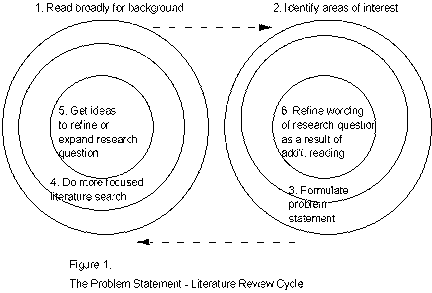
One good thing (at least .. !) about the above cycle: those circles do get smaller! This represents the sequential focus in the process. At first you need to read, and think, rather broadly. As you zero in on your areas of interest, you'll continue to read and research, but this time in a more specific, focused manner, as it relates to your evolving problem statement. As a result of this reading, you may further refine or narrow your problem statement, and so forth. You eventually reach the point (I promise!) where:
- your problem statement is in focused, finished form; and
- your subsequent reading is restricted to just-published updates - hot-off the presses publications, perhaps - in the areas of your focused problem statement/sub problems (a).
Now ... there are at least as many potential ways to do a literature review as there are research topics! (Think "infinity + 1"!) Despite this magnificent diversity, it is still possible to specify some general guidelines, tips, rules of thumb, etc., to help you navigate the waters of your own topic! That's the objective of this learning module! So as long as you look before you leap, the water ought to be just fine ... !
Open the link below for some tips on writing a literature view from the University of Toronto.
Writing a Literature Review in the Health Sciences and Social Work
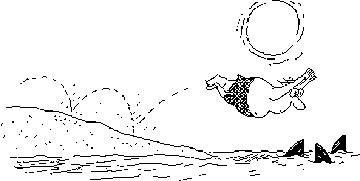
Strategies for A Successful Literature Review
- Think "set the stage." It's a mistake to think, "I've got
to summarize everything that's ever been written about this topic!"
That's an understandable assumption: after all, haven't we been well-trained
in it every time we've produced a traditional "term paper" as part of
a class assignment? It's also the way to success if your goal is to
produce a publishable monograph on a given topic.
For the dissertation, however, you need to be much more focused!
A good literature review will in essence "set the stage" for your
particular problem statement or research question. That means zeroing
in on the key variables, themes, etc., of that research question and
then presenting prior work as it relates to or supports those key
variables.
Of course, you will need to read much more broadly at the outset
-- when you're still at the 'what am I interested in?' stage of pinning
down your eventual research question. This is depicted as the outermost
concentric circle on the left in the preceding Figure 1. In fact,
at this stage you may find yourself "rejecting" as many pieces of
prior work as you "accept!" That is: you'll locate an article and
start to read it, only to find that it doesn't quite seem to fit your
needs and interests. But that's OK: it is as helpful to know what
you don't need, and why, as what you do!
But once you pin down even a rough cut of your eventual problem
statement, you'll already have some focus. That problem statement
will contain key variables, perhaps deal with certain sub populations,
or time periods, or other such "delimiting" factors.
This first stage of focus will help you to go through your box,
index of file cards, computer printout, etc. of your literature sources
to date and do some prudent "weeding out" at this point. You may discover
that an article was helpful in helping you pin down your general area
of interest -- but now that you've begun to focus, it's a bit too
broad and doesn't quite 'fit.' This is the general idea of such related
literature review focus.
- Draft out a "subtopic breakdown outline" to subdivide the "flow"
of your literature review from general to specific. This is one
of the best ways to put point # 1, above, into practice! Remember doing
those subtopic outlines? I had an English teacher who insisted that
it was the best way to organize oneself and one's strategy before putting
pen to paper on that term paper. The best way to do this is to try and
structure your breakdown to flow from general to specific as much as
possible. Then run through it as a 2nd pass, and further break down
the major topic subheadings into sub-sub-topic discussions; e.g.,
- First major subtopic
- Related sub-sub-topic #1
- Further breakdown
- Further breakdown
- Related sub-sub-topic #2
-
- Further breakdown
- Further breakdown
-
- Further breakdown
- Further breakdown
- Second, more specific subtopic
- Related sub-sub-topic #1
- Further breakdown
- Further breakdown
- Related sub-sub-topic #2
-
- Further breakdown
- Further breakdown
-
- Further breakdown
- Further breakdown
etc., etc.
The above subtopic breakdown will probably begin to become evident
to you after that one (or more) broad delvings into the literature.
Once you immerse yourself in a broad sampling in everything that's
been written about that topic, you'll be able to discern how researchers
before you have broken down that topic, as they see it. This broader
immersion will prepare you to develop the preceding subtopic breakdown.
When you are able to produce the preceding subtopic outline, you'll
have at least two benefits from it:
- You'll essentially have your subheadings for your Chapter Two;
- As you continue your focused reading in the existing literature,
you'll be able to classify each publication, article, etc., under
one of the preceding subtopic subheadings. In other words, you now
have a handy system for "indexing" the references that you'll eventually
summarize and write up for your Chapter Two.
One of the biggest problems we see with Chapter Two drafts - submitted
first for comps and then the prospectus hearing - is not enough subdivision
of Chapter Two into such general-to-specific logical subheadings.
In other words, the writer hasn't quite thought out this subtopic
breakdown. Sooner or later, he/she 'gets derailed' and more or less
starts "dumping" narrative. The connection to the problem statement,
as well as any semblance of logical cohesiveness, quickly becomes
lost -- as does the outside reader!
For the topic of evaluating the outcomes of the Arizona Career Ladder
Teacher Incentive and Development Program, for instance, the rough
breakdown and flow might begin as follows:
* Issues in teacher recruitment and retention;
* A review of past and present incentive programs generally;
* Career Ladder programs throughout the country;
* Early efforts in Arizona;
* A brief history of the Arizona Career Ladder Program;
* Needs/gaps in evaluation efforts of this program to date.
Do you see how this 'sets the stage' for your own subsequent desire
to do an evaluation of this program? You start broadly by discussing
general (theoretical and practical) problems and issues involved in
recruiting and retaining top-quality teachers. Then you key in on
past programs and efforts to create such teacher incentive programs.
Then you focus further on Career Ladders as a particular form of incentive
programs, and you look at nationwide experiments with Career Ladders.
Your next attempt at focus is the Career Ladder Program in Arizona
itself. You provide a historical overview of the Arizona program,
as well as past attempts to gauge its success, or lack thereof. By
doing so, you nicely set the stage for the need for your own evaluation
study of the Arizona Career Ladder Program.
Others (Creswell, 1994; Packard, 1992) prefer to think of the above
as an "inverted triangle":
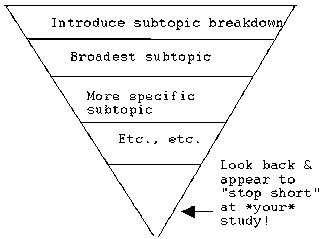
... and the preceding leads us into the next tip:
- Start with your "road map." It is a good idea to begin your
Chapter Two with an "Introduction" section or paragraph. In this introduction,
I recommend that you "preview" for the reader your intended breakdown
of your lit review. In essence, this would consist of your subtopic
subheadings as contained in the preceding "outline" or "inverted triangle"
format.
This is so helpful in giving the reader a "road map" of how you
intend to proceed. In particular, it's a boon to "content-area outsiders"
(like me!). One rule of thumb for a successful Chapter Two lit review
is this: a content-area outsider should be able to read your Chapter
Two and acquire enough of an understandable, "broad-brush" background
so that he/she (the outsider) can see where your problem statement
fits in the "scheme of things" -- e.g., related past research.
That may seem like a tall order, indeed! But probably the biggest
key to success is careful prior organization on your part -- e.g.,
in the form of a well-thought-out subtopic breakdown (outline or inverted
triangle, as per our tip # 2). In addition, if you provide the reader
with this intended 'road map' up front -- the old journalism line
of "tell 'em what you're gonna tell 'em" the reader is less likely
to get lost in the narrative.
- Blend, blend, blend!!! That's the trick to "good, interesting
writing" of the 'meat' of Chapter Two!
If you've taken the time to do a good subtopic (outline or inverted
triangle) breakdown, you've already got your subheadings for Chapter
Two. But -- how do you "package" the content you'll be presenting
under each of these subheadings?
In my extensive experience helping our dissertation partners with
their Chapter Two drafts, I would suggest that the following "blend"
is a desirable way to write the content -- and 'keep it interesting'
as well!
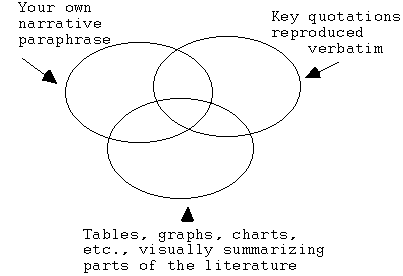
Perhaps another way to look at the preceding "recipe for ideal blend"
is by identifying some common mistakes made by Chapter Two writers:
- Being afraid to paraphrase the work of "giants." This one
is probably the result of "excess humility/doctoral candidate (and
jr. faculty member) insecurity!" You think to yourself, "I can't
possibly do justice to these 'giants' by restating them in my own
words!" Which leads us right into the following . . .
- Too much literal restatement. Soon the narrative reads
as follows: Smith (1993) said.....
According to Jones and Brown (1992) ...
Green (1989) stated ...
Dull, dull, dull! Without meaning to, you've slipped
into the "term paper chronology" that we spoke of earlier! Also,
before you know it, you effectively lose your link to your problem
statement.
Much better - for you to restate the "crux" of the conclusion
of that paper, or a bunch of paper(s), at it relates back to your
problem statement -- then, selectively "buttress" that
conclusion with appropriate, relevant citations. For instance:
"The major motivating factor in successful implementation of teacher
incentive programs is intrinsic rewards. For example, Green (1989)
found ... " You've now gone out on a limb and provided the reader
with the "bottom line" of these studies, especially as it relates
to your own eventual research. Then you give more specific support
for that "bottom line" by citing the leading lights from the past
who've worked in the area.
- More relevant! Keeps us focused on the end goal; e.g.,
your problem statement!
- More interesting to read! You give us the conclusions
with your scholarly assertiveness and then you selectively pick
prior researchers to support your conclusion!
- Overquoting. This essentially results from the same insecurity
(and can be just as dull to read) as the "Smith said," "Jones found"
problem of the preceding point. Overcitation of many lengthy quotes
is a giveaway to your fear and reluctance to trust your own scholarly
ability to restate the key points made in the quotes!
As I like to point out in my qualitative research classes, you
should use literal quotes the way a good cook uses spices:
Not enough means the dish is too bland; and
Too much means you've obscured the flavor of the main course!
The acid test for deciding to include a quote should be this:
"Is it said so colorfully, vividly, memorably, etc., that restating
it would essentially 'excise its heart and soul?'" If it will
add 'spice' and interest for the reader in its present form, by
all means sprinkle it in! At most, however, only a handful of
quotations will meet this inclusion criterion. Where possible,
you should try and paraphrase in your own words, as well as possibly
"blend" with results of other studies, to form "broad conclusions"
that relate directly to your problem statement - as indicated
in the Career Ladder illustration earlier.
To summarize and relate to the "prescription for effective writing"
diagrammed above:
Under each subheading (from outline or inverted triangle), blend:
- Your own summary narrative (broad conclusions of one study,
or a group of studies, as they relate to your subproblem - "bottom
line") supported by selective citations (please see Career Ladder
illustration).
- Judicious, sparing use of direct quotations to add interest;
- Inclusion of "interesting summary visuals" (e.g., tables, graphs,
charts) - either created by you or cited from prior studies
- again, to add interest and as a visual contrast to your narrative
- "Put on the brakes" with a strong transitional "Summary" ending
to Chapter Two. If I had to give you a single tip, regarding what
distinguishes an outstanding Chapter Two from a 'so-so' one, this would
be it!
Here's what I mean -- you've set the stage with the Intro, and then
launched into a systematic, organized, interesting blend of writing
under each of your subheadings. Now -- if you've also carefully sequenced
those subheadings into a general-to-specific flow, you've now arrived
at the "point" of that inverted triangle diagram.
You've skillfully "put on the brakes" at just exactly the
point at which prior work ends, and you've gotten the reader to see
how your particular study is the logical next step in the research
chain, or life cycle, on this topic!!!
Briefly summarize the major themes or trends of the literature review that you've just finished in depth. That is: "tell 'em what you just told 'em" -- in condensed 'Reader's Digest' form. Then, skillfully "stop short" at exactly the point where the reader 'sees' how your particular research question/problem statement would be the logical next step in the body of research in this area to date!
If you'll recall our diagram of the research chain or life cycle from our first lesson of the Intro to Research module we saw that it is really ongoing and cyclical in nature. Another researcher always picks up where his/her predecessor left off, to further illuminate our scientific understanding of the phenomenon being investigated. In fact, we learned in our own preceding Research Design lesson packet that this is a particularly rich source of ideas for topics to study! See where someone else left off -- and you pick up the slack with your own (next) research question!
This is the "end goal" (pun intended) for closing up Chapter Two!
- Remember! The next thing after the "end" (summary) of Chapter Two will be Chapter Three - the blueprint for carrying out your own research study!!!!
That's why it's desirable to create a smooth transition to your blueprint, via your Chapter Two Summary!
- - -
Let's recap! We've produced the following general framework for organizing and writing a "good" Chapter Two literature review:
Introduction
"Tell 'em what you're gonna tell 'em:" preview your intended subtopic breakdown (subheadings) for the reader
Under Each Subheading - As Per Outline or Inverted Triangle
- Summary narrative: your restatement of broad conclusions as related to your problem statement, supported by leading-light citations;
- Key illustrative quotations: use judiciously, sparingly;
- Summary visuals - tables, charts, graphs, etc.:
- as reproduced from prior work;
- your own creative visual summaries, to add interest
Summary
- "Tell 'em what you just told 'em:" review the major themes or threads of the literature review just completed in detail
- "Skillfully put on the brakes" at exactly the point at which prior work stops and your study is perceived by the reader as the logical next step in the research chain
- - -
With regard to "how to actually do literature searches," it is helpful to hook up with a university-based library in your town. They can show you how to search computerized databases to find sources related to your topic(s) of interest.
You might want to start with the online databases at the NAU Cline Library. Click on the link below, then select your area of interest. This will take you to a list of available databases at Cline Library. Also, check out the "Internet Search Tools, and "Electronic Books" and "Electronic Journals." links.
Cline Library
- - -
Hope these tips have been helpful! And remember, it doesn't have to be as bad as the following ... !
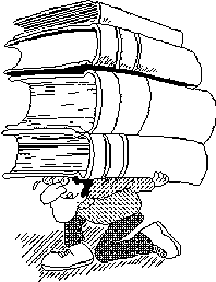
Once you have finished you should:
Go on to Assignment 1: A One Minute Paper
or
Go back to Blast from the Past: The Literature Review
E-mail M. Dereshiwsky
at statcatmd@aol.com
Call M. Dereshiwsky
at (520) 523-1892

Copyright © 1999
Northern Arizona University
ALL RIGHTS RESERVED
|


